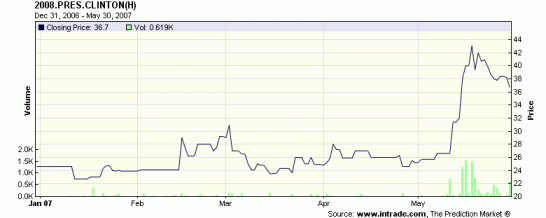Via Matt Drudge, via EITB 24, a hacker whose pseudonym is “Gabriel” tells you the ending of the book, The Deathly Hallows, yet to be published. He claims to have hacked one of the computers of the publisher. The bottom line is that Harry does not die, it seems.
I have just bought all the NewsFutures “Harry Potter will survive” contracts I could snap at $80. Plus, I was granted 10 pairs of contracts thru this program, and I sold the 10 “no” contracts to some misinformed trader at $20. Here’s my VIP page at NewsFutures. [I previously flip-flopped on this issue. ![]() ]
]
Just a short note on the NewsFutures prediction exchange: very usable. Our good doctor EJSS and his employees are detail oriented, and I think that’s the way to go. As I have written 10 times on Midas Oracle, this is about satisfying the sophisticated bettors, not the Joe Six-Packs. The folks at Pop Sci’s PPX should take notice. You know, I am on the receiving end of many youngsters’ claims to be “the next NewsFutures”. Well, my message to them: get up earlier, boys.
Here are all the blog posts and comments written about Harry Potter on Midas Oracle.
If I’m right to trust the hacker “Gabriel” and I win this game, then I’ll publish a victory blog post against Niall O’Connor and Michael Giberson. Niall O’Connor swallowed the William Hill story (All the money was on Harry Potter to die, so they stopped taking bets) like a lake carp swallows a peanut butter doughball. But, that’s too early. Let’s wait and see.
—
Harry Potter will survive The Deathly Hallows.

© NewsFutures
—
UPDATE: The sentiment of the majority favors the Niall O’Connor theory that puts William Hill at the receiving end of insider information (”Harry Potter dies”), lately. And the NewsFutures market-generated probability would reflect the (misinformed, on this one) “wisdom of crowds”, which kind of senses that an author for kids will not make the hero die. We’ll see.
UPDATE #2: eWeek.com
milw0rm is a group of politically motivated “hacktivists” whose most famous exploit was penetrating the computers of the Bhabha Atomic Research Centre (BARC) in Bombay, the primary nuclear research facility of India, on June 3, 1998. They have anti-nuclear and pro-peace agendas and, in this case, anti-Harry Potter and pro-Pope Benedict XVI.
UPDATE: The contract of the Harry Potter event derivative at NewsFutures may be flawed.
NEXT: THE FATE OF HARRY POTTER IN J.K. ROWLING’S 7TH BOOK, THE DEATHLY HALLOWS: prediction market vs. bookmaker + NEWSFUTURES JUDGES THAT HARRY POTTER IS STILL ALIVE AT THE END OF J.K. ROWLING’S 7TH NOVEL, THE DEATHLY HALLOWS.


